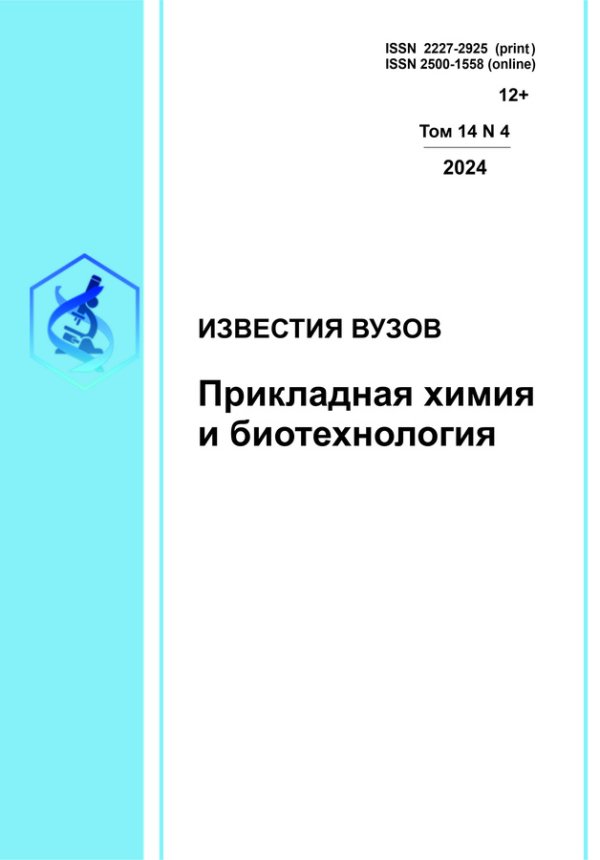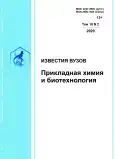Синтез и строениe 1-алкокси-1,4-диоксо-2- алкенолятов натрия и бис-(4-алкил(арил)-1-оксо- 1-алкоксиалкан-2,4-дионато)металлов(II) на их основе
- Авторы: Кунавина Е.А.1, Пешков С.А.1, Искандаров А.Ю.2
-
Учреждения:
- Оренбургский государственный университет
- Ташкентский государственный педагогический университет
- Выпуск: Том 10, № 2 (2020)
- Страницы: 180-187
- Раздел: Химические науки
- URL: https://ogarev-online.ru/2227-2925/article/view/299672
- DOI: https://doi.org/10.21285/2227-2925-2020-10-2-180-187
- ID: 299672
Цитировать
Полный текст
Аннотация
Синтез практически значимых металлокомплексов с карбонилсодержащими лигандами является приоритетной задачей современной органической химии. Комплексообразованием 1-алкокси-1,4-диоксо-2-алкенолятов натрия, полученных конденсацией алкил(арил)метилкетонов с диалкилоксалатами в присутствии в качестве конденсирующего реагента натрия или гидрида натрия, с солями металлов (цинка(II), меди(II) и никеля(II)) выделены новые бис-(4-алкил(арил)-1-оксо-1-алкоксиалкан-2,4-дионато)металлы(II). Строение синтезированных оксоенолятов натрия и металлокомплексов подтверждено спектральными методами анализа (ИК-, ЯМР 1Н-, ЯМР 13С-спектроскопии и масс-спектрометрии). В ИК-спектрах твердых образцов выделенных соединений обнаружены полосы валентных колебаний сложноэфирных карбонильных групп, а также эфирные полосы высокой интенсивности, обусловленные колебаниями связей С-О-С. Для соединений, содержащих ароматические фрагменты в ИК-спектрах, найдены полосы, отвечающие колебаниям монозамещенных бензольных колец. В спектрах ЯМР 1Н оксоенолятов натрия и металло-комплексов, записанных в ДМСО-d6, присутствуют классические сигналы этокси- и н-бутоксифрагментов, метиновых протонов, а также протонов ароматических колец. Химические сдвиги углеродных атомов в спектрах ЯМР 13С окоенолятов натрия хорошо сопоставимы со справочными значениями. В масс-спектрах синтезированных соединений, зарегистрированных в режиме электрораспыления, наблюдаются сигналы протонированных и катионированных молекул [M+H]+, [M+NH4]+, [M+Na]+, [M+K]+. С использованием квантово-химических методов построены модели полученных соединений и рассчитаны энергии образования и константы диссоциации. Оптимизация геометрических параметров равновесных состояний оксоенолятов натрия и металлокомплексов произведена в рамках двух методов: теории функционала плотности (DFT) и самосогласованного поля (SCF). Относительные величины энергий образования свидетельствуют о высокой стабильности синтезированных веществ, при этом, согласно полученным данным, большей устойчивостью в газовой фазе характеризуются медные комплексы.
Ключевые слова
Об авторах
Е. А. Кунавина
Оренбургский государственный университет
Автор, ответственный за переписку.
Email: kea20072007@yandex.ru
С. А. Пешков
Оренбургский государственный университет
Email: darvin156@mail.ru
А. Ю. Искандаров
Ташкентский государственный педагогический университет
Email: oybekiskandarov@mail.ru
Список литературы
- Popov L.D., Morozov A.N., Shcherbakov I.N., Tupolova Yu.P., Lukov V.V., Kogan V.A. Metal complexes with polyfunctional ligands based of bis(hydrazones) of dicarbonyl compounds // Russian Chemical Reviews. 2009. Vol. 78. Issue 7. P. 643–658. https://doi.org/10.1070/RC2009v078n07ABEH003890
- Levchenkov S.I., Shcherbakov I.N., Popov L.D., Lyubchenko S.N., Tsaturyan A.A., Beloborodov S.S., et al. Transition metal comple-xes with 2,6-di-tert-butyl-p-quinone 1′-phthalazinylhydrazone // Russian Journal of General Chemistry. 2013. Vol. 83. Issue 10. P. 1928–1936. https://doi.org/10.1134/S1070363213100216
- Burlov A.S., Zaichenko S.B., Popov L.D., Vlasenko V.G., Borodkin G.S., Makarova N.I., et al. Synthesis, structure, and spectral properties of 3,5-di-tert-butyl-1,2-benzoquinone 3-hydroxynaphthoylhydrazone and Its complexes with Zn(II), Cd(II), Ni(II), Co(II) // Russian Journal of General Chemistry. 2019. Vol. 89. Issue 4. P. 727–735. https://doi.org/10.1134/S1070363219040157
- Popov L.D., Shcherbakov I.N., Tupolova Y.P., Etmetchenko L.N., Kogan V.A., Levchenkov S.I., et al. Copper(II) complexes with N-(phenyl)alkylthiosemicarbazones of 3,5-dichlo-ro- and 3,5-diiodosalicylic aldehydes // Russian Journal of General Chemistry. 2016. Vol. 86. Issue 2. P. 344–348. https://doi.org/10.1134/ S1070363216020249
- Shcherbakov K.V., Burgart Ya.V., Saloutin V.I. Metal complexes based on functionalized 4-hydroxypolyfluorocoumarins // Russian Journal of Organic Chemistry. 2014. Vol. 50. Issue 6. P. 815–821. https://doi.org/10.1134/S1070428014060104
- Melkozerov S.A., Pervova I.G., Lipunov I.N., Dvoskin E.A., Lipunova G.N., Barachevskii V.A. Synthesis and photoluminescence properties of zinc(II) complexes with salicylaldehyde hetarylhydrazones // Russian Journal of General Chemistry. 2013. Vol. 83. Issue 4. P. 646–651. https://doi.org/10.1134/S1070363213040063
- Kudyakova Yu.S., Goryaeva M.V., Burgart Ya.V., Saloutin V.I. Asymmetric azomethine ligands based on 2--3-oxo-3- polyfluoroalkylpropionates and aldehydes // Russian Chemical Bulletin. 2010. Vol. 59. Issue 9. P. 1753–1760. https://doi.org/10.1007/s11172-010-0308-8
- Metelitsa A.V., Burlov A.S., Borodkina I.G., Bren V.A., Garnovskii A.D., Minkin V.I., et al. Luminescent complexes with ligands containing C=N bond // Russian Journal of Coordination Chemistry. 2006. Vol. 32. Issue 12. P. 858–868. https://doi.org/10.1134/S1070328406120025
- Blokhin Y.I., Lyubimov I.A., Bagautdinov A.M., Abramov I.A., Khotina I.A., Karnoukhova V.A. Copper(I) complexes with phenylphosphonous acid diamide // Russian Journal of Coordination Chemistry. 2016. Vol. 42. Issue 6. P. 372–377. https://doi.org/10.1134/S1070328416060014
- Yang T., Niu F., Li L.X., Xia Z.N., Zhang Y., You Z.L. Synthesis, characterization, crystal structures, and antimicrobial activity of cobalt(II) and iron(III) complexes derived from n-(2-hydroxybenzylidene)-3-methylbenzohydrazide // Russian Journal of Coordination Chemistry. 2016. Vol. 42. Issue 6. P. 402–409. https://doi.org/10.1134/S1070328416050109
- Кувшинова Е.М., Быкова М.А., Вершинина И.А., Горнухина О.В., Любимова Т.В., Семейкин А.С. Синтез и координационные свойства кобальтовых комплексов 5-фенил-2,3,7,8,12,18-гексаметил-13,17-диэтилпорфина и его нитрозамещенных в органических растворителях // Известия высших учебных заведений. Серия: Химия и химическая технология. 2018. Т. 61. N 7. С. 44–49. https://doi.org/10.6060/ ivkkt.20186107.5843
- Кudayarova Т.V., Тyutina M.A., Danilova Е.А. Сomplexes of izothiadiazole- containing bromonitrosubstituted three units product with d-metals (Ni, Co, Zn) // Известия высших учебных заведений. Серия: Химия и химическая технология. 2018. Т. 61. N 12. С. 68–73. https://doi.org/10.6060/ivkkt.20186112. 5799
- Chizhova N.V., Ivanova Yu.B., Mamardashvili N.Z., Rusanov A.I., Khrushkova Y.V. Synthesis and spectral and fluorescent properties of metal complexes of octakis(4-
- flurophenyl)tetraazaporphyrins // Russian Journal of Organic Chemistry. 2019. Vol. 55. Issue 5. P. 655–661. https://doi.org/10.1134/S1070428019050129
- Seifullina I.I., Martsinko E.É., Chebanenko E.A., Gridina T.L., Mudrik L.M., Fedchuk A.S. Antiviral properties of the new coordination compound silver bis(citrato)germanate // Pharmaceutical Chemistry Journal. 2019. Vol. 53. Issue 4. P. 318–321. https://doi.org/10.1007/s11094-019-01999-w
- Mustafina A.R., Skripacheva V.V., Konovalov A.I. Outer-sphere association of calixarenes and other macrocyclic ligands with metal complexes as the basis for the design of molecular devices // Russian Chemical Reviews. 2007. Vol. 76. Issue 10. P. 917–930. http://doi.org/10.1070/RC2007v076n10ABEH003727
- Амерханова Ш.К., Нуркенов О.А., Уали А.С., Сатпаева Ж.Б., Абдикен Ф.С.
- Синтез и комплексообразующая способность n-2-(2-гидроксибензоил)-гидразинокарбонотиоилбензамида (II) по отношению к ионам La3+, Y3+, Nd3+ в бинарной смеси «вода–1,4-диоксан» // Известия вузов. Прикладная химия и биотехнология. 2016. Т. 6. N 4. С. 9–14. https://doi.org/10.21285/2227-2925-2016-6-4-9-14
- Peshkov S.A., Khursan S.L. Complexation of the Zn, Co, Cd, and Pb ions by metallothioneins: A QM/MM simulation // Computational and Theoretical Chemistry. 2017. Vol. 1106. P. 1–6. http://doi.org/10.1016/ j.comptc.2017.02.029
Дополнительные файлы










